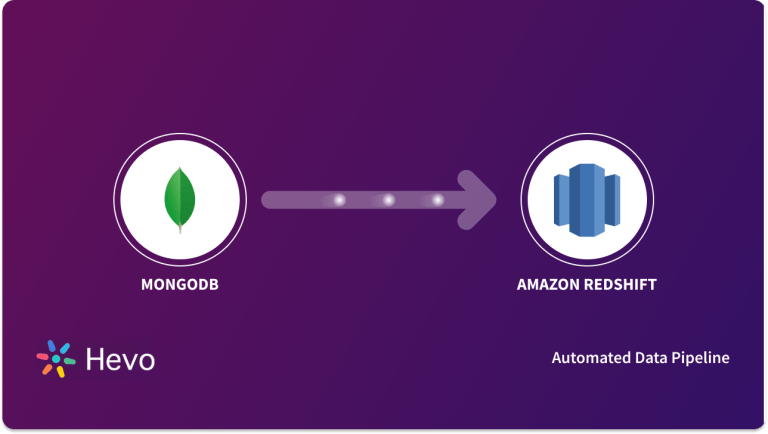 Key Takeaways
Key TakeawaysMigrating data from MongoDB to MySQL requires different approaches depending on the complexity and volume of data. Below are three methods to consider for this migration:
Method 1: Using Hevo Data
Hevo Data automates the migration process from MongoDB to MySQL, ensuring seamless data transfer without coding.
Method 2: Using CSV File Export/Import
This method involves exporting MongoDB data to a CSV file and importing it into MySQL using MySQL’s import wizard.
Method 3: Using MongoDB Relational Migrator
MongoDB Relational Migrator is a tool that helps convert MongoDB collections into relational schema suitable for MySQL.
Migrating data between databases can be challenging, especially when switching from a NoSQL database like MongoDB to a relational database like MySQL. Whether you’re moving to MySQL for its structured data handling or enhanced compatibility with existing systems, finding the correct method is crucial.
This blog explores two simple yet effective ways to migrate your data from MongoDB to MySQL: a manual CSV Export/Import method or an automated solution like Hevo Data. Along the way, read about the prerequisites, step-by-step instructions, and practical use cases to ensure a smooth transition. By the end, you’ll have all the insights you need to make your migration seamless and efficient. Let’s get started!
Table of Contents
What is MongoDB?

MongoDB is a popular open-source, non-relational, document-oriented database. Instead of storing data in tables like traditional relational databases, MongoDB stores data in flexible JSON-like documents with dynamic schemas, making it easy to store unstructured or semi-structured data.
Key Features
- Document-oriented storage: More flexible and capable of handling unstructured data than relational databases. Documents map nicely to programming language data structures.
- High performance: Outperforms relational databases in many scenarios due to flexible schemas and indexing. Handles big data workloads with horizontal scalability.
- High availability: Supports replication and automated failover for high availability. Enable real-time data syncing using MongoDB CDC in time-critical reporting.
- Scalability: Scales horizontally using sharding, allowing the distribution of huge datasets and transaction load across commodity servers. Elastic scalability for handling variable workloads.
What is MySQL?
MySQL is a widely used open-source Relational Database Management System (RDBMS) developed by Oracle. It employs structured query language (SQL) and stores data in tables with defined rows and columns, making it a robust choice for applications requiring data integrity, consistency, and reliability. Connect other databases such as MariaDB to MySQL and manage databases of websites and applications with high traffic.
Key Features
- Full support for ACID (Atomicity, Consistency, Isolation, Durability) transactions, guaranteeing accuracy of database operations and resilience to system failures – vital for use in financial and banking systems.
- Implementation of industry-standard SQL for manipulating data, allowing easy querying, updating, and administration of database contents in a standardized way.
- Database replication capability enables MySQL databases to be copied and distributed across servers. This facilitates scalability, load balancing, high availability, and fault tolerance in mission-critical production environments.
Ditch the manual process of writing long commands to connect MongoDB and MySQL, and choose Hevo’s no-code platform to streamline your data migration.
With Hevo:
- Easily migrate different data types like CSV, JSON, etc.
- 150+ connectors like MongoDB and MySQL(including 60+ free sources).
- Eliminate the need for manual schema mapping with the auto-mapping feature.
Experience Hevo and see why 2000+ data professionals, including customers such as Thoughtspot, Postman, and many more, have rated Hevo 4.4/5 on G2.
Get Started with Hevo for FreeMethods to Set Up MongoDB to MySQL Integration
There are many ways of loading data from MongoDB to MySQL. In this article, you will be looking into two popular ways. In the end, you will understand each of these two methods well. This will help you to make the right decision based on your use case:
Prerequisites
- MongoDB Connection Details
- MySQL Connection Details
- Mongoexport Tool
- Basic understanding of MongoDB command-line tools
- Ability to write SQL statements
Method 1: Using Hevo Data
The steps to load data from MongoDB to MySQL using Hevo Data are as follows:
Step 1: Configure MongoDB as your Source
Step 2: Select MySQL as your Destination
Hevo automatically flattens all the nested JSON data coming from MongoDB and automatically maps it to MySQL destination without any manual effort. You can also learn how to connect MongoDB Atlas to MySQL to leverage SQL querying capabilities.
Method 2: Using CSV File Export/Import
MongoDB and MySQL are incredibly different databases with different schema strategies. This means there are many things to consider before moving your data from a Mongo collection to MySQL. The simplest of the migration will contain the few steps below.
Step 1: Extract data from MongoDB in a CSV file format
Use the default mongoexport tool to create a CSV from the collection.
mongoexport --host localhost --db classdb --collection student --type=csv --out students.csv --fields first_name,middle_name,last_name, class,email- In the above command,
classdbis the database name, the student is the collection name and students.csv is the target CSV file containing data from MongoDB. - An important point here is the –field attribute. This attribute should have all the lists of fields that you plan to export from the collection.
- If you consider it, MongoDB follows a schema-less strategy, and there is no way to ensure that all the fields are present in all the documents.
- If MongoDB were being used for its intended purpose, there is a big chance that not all documents in the same collection have all the attributes.
Hence, while doing this export, you should ensure these fields are in all the documents. If they are not, MongoDB will not throw an error but will populate an empty value in their place.
Step 2: Create a student table in MySQL to accept the new data.
Use the Create table command to create a new table in MySQL. Follow the code given below.
CREATE TABLE students ( id INT(6) UNSIGNED AUTO_INCREMENT PRIMARY KEY, firstname VARCHAR(30) NOT NULL, middlename VARCHAR(30) NOT NULL, lastname VARCHAR(30) NOT NULL, class VARCHAR(30) NOT NULL, email VARCHAR(30) NOT NULL, )Step 3: Load the data into MySQL
Load the data into the MySQL table using the below command.
LOAD DATA LOCAL INFILE 'students.csv' INTO TABLE students FIELDS TERMINATED BY ',' ENCLOSED BY '"' LINES TERMINATED BY 'n' (firstname,middlename,lastname,class,email)Limitations of Using the CSV Export/Import Method | Manual setting up
- Data Structure Difference: MongoDB has a schema-less structure, while MySQL has a fixed schema. This can create an issue when loading data from MongoDB to MySQL, and transformations will be required.
- Time-Consuming: Extracting data from MongoDB manually and creating a MySQL schema is time-consuming, especially for large datasets requiring modification to fit the new structure. This becomes even more challenging because applications must run with little downtime during such transfers.
- Initial setup is complex: The initial setup for data transfer between MongoDB and MySQL demands a deep understanding of both databases. Configuring the ETL tools can be particularly complex for those with limited technical knowledge, increasing the potential for errors.
Bonus Method 3: Using MongoDB Relational Migrator
You can migrate data from MySQL to MongoDB using the MongoDB Relational Migrator, which helps map relational schemas to MongoDB’s flexible document model. It supports both snapshot and continuous migration for seamless data transfer.
Read the detailed steps on moving MongoDB Data to MySQL using MongoDB Relational Migrator here.
Use Cases of MongoDB to MySQL Migration
- Structurization of Data: When you migrate MongoDB to MySQL, it provides a framework to store data in a structured manner that can be retrieved, deleted, or updated as required.
- To Handle Large Volumes of Data: MySQL’s structured schema can be useful over MongoDB’s document-based approach for dealing with large volumes of data, such as e-commerce product catalogs. This can be achieved if we convert MongoDB to MySQL.
You can also clone a database for testing in MySQL by migrating MySQL databases between two servers.
MongoDB compatibility with MySQL
Although both MongoDB and MySQL are databases, you cannot replace one with the other. A migration plan is required if you want to switch databases. These are a few of the most significant variations between the databases.
Querying language
- MongoDB has a different approach to data querying than MySQL, which uses SQL for the majority of its queries.
- You may use aggregation pipelines to do sophisticated searches and data processing using the MongoDB Query API.
- It will be necessary to modify the code in your application to utilize this new language.
Data structures
- The idea that MongoDB does not enable relationships across data is a bit of a fiction.
- Nevertheless, you may wish to investigate other data structures to utilize all of MongoDB’s capabilities fully.
- Rather than depending on costly JOINs, you may embed documents directly into other documents in MongoDB.
- This kind of modification results in significantly quicker data querying, less hardware resource usage, and data returned in a format that is familiar to software developers.
Additional Resources for MongoDB Integrations and Migrations
- Connect MongoDB to Snowflake
- Connect MongoDB to Tableau
- Sync Data from MongoDB to PostgreSQL
- Move Data from MongoDB to Redshift
- Replicate Data from MongoDB to Databricks
Conclusion
This article gives detailed information on migrating data from MongoDB to MySQL. It can be concluded that Hevo seamlessly integrates with MongoDB and MySQL, ensuring that you see no delay in setup and implementation.
Businesses can use automated platforms like Hevo Data to export data and handle the ETL process. It helps you directly transfer data from a source of your choice to a Data Warehouse, Business Intelligence tools, or any other desired destination in a fully automated and secure manner without having to write any code. So, to enjoy this hassle-free experience, sign up for our 14-day free trial and make your data transfer easy!
Also, check out our unbeatable pricing for the best plan that fits your needs.
FAQ on MongoDB to MySQL
1. Can I migrate from MongoDB to MySQL?
Yes, you can migrate your data from MongoDB to MySQL using ETL tools like Hevo Data.
2. Can MongoDB connect to MySQL?
Yes, you can connect MongoDB to MySQL using manual methods or automated data pipeline platforms.
3. How to transfer data from MongoDB to SQL?
To transfer data from MongoDB to MySQL, you can use automated pipeline platforms like Hevo Data, which transfers data from source to destination in three easy steps:
Configure your MongoDB Source.
Select the objects you want to transfer.
Configure your Destination, i.e., MySQL.
4. Is MongoDB better than MySQL?
It depends on your use case. MongoDB works better for unstructured data, has a flexible schema design, and is very scalable. Meanwhile, developers prefer MySQL for structured data, complex queries, and transactional integrity.









